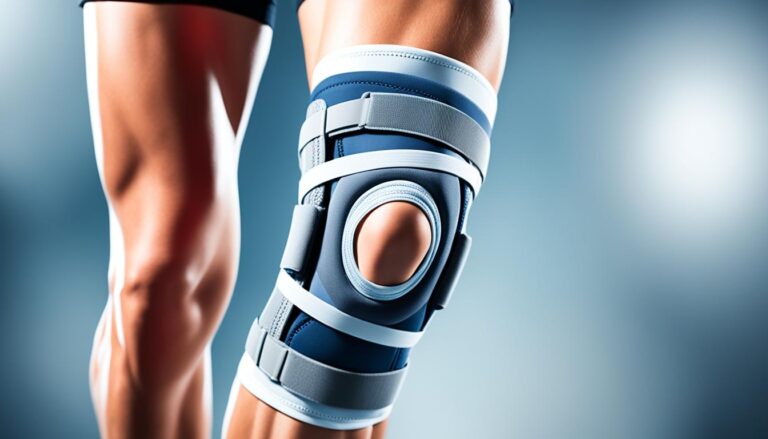Knee Injuries When Falling: Prevention & Care
Did you know that knee injuries from falling are alarmingly common? Whether it’s a slip, a trip, or a stumble, falling can lead to a range of knee injuries, from mild sprains to severe fractures and dislocations. These injuries can have a significant impact on daily activities and quality of life.
When we think of falls, we often associate them with older adults. However, knee injuries from falling can happen to people of all ages and fitness levels. No one is immune to the potential dangers of a fall, especially when it comes to our knees.
The consequences of knee injuries from falling can be far-reaching. Ligament injuries, such as anterior cruciate ligament (ACL) tears, medial collateral ligament (MCL) tears, and posterior cruciate ligament (PCL) tears, are particularly common. Meniscus injuries, fractures, dislocations, and bursitis are also prevalent in cases of falling.
Seeking medical attention is crucial after sustaining a knee injury from a fall. A healthcare professional can provide an accurate diagnosis and recommend the appropriate course of treatment. Options may include rest, ice, compression, physical therapy, medication, or, in more severe cases, surgery.
While accidents happen, there are preventive measures we can take to reduce the risk of knee injuries when falling. Wearing proper footwear, avoiding uneven surfaces, and incorporating strength training and low-impact exercises into our routine can all contribute to better knee health and minimize the chances of a fall-related injury.
In this article, we will explore common knee injuries from falling, discuss treatment options, and provide valuable insights into preventing knee injuries when falling. Whether you have experienced a knee injury or want to protect yourself and your loved ones from potential harm, this article will equip you with the knowledge and tools to promote knee health and overall well-being.
Common Knee Injuries from Falling
Falling can result in a range of knee injuries, including ligament injuries, meniscus injuries, fractures, dislocation, and bursitis. Let’s take a closer look at each of these common knee injuries from falling:
Ligament Injuries
One of the most prevalent knee injuries from falling is damage to the ligaments, which are fibrous tissues that connect bones in the joint. Ligament injuries can include tears in the anterior cruciate ligament (ACL), medial collateral ligament (MCL), and posterior cruciate ligament (PCL). These injuries can cause pain, instability, and difficulty walking or running.
Meniscus Injuries
The meniscus is a piece of cartilage that acts as a cushion between the bones of the knee joint. Falling can lead to meniscus injuries, resulting in pain, swelling, and limited mobility. These injuries can make it challenging to bend or extend the knee fully.
Fractures
When you fall, the bones of the knee joint can suffer fractures or breaks. Common fractures from falling include those in the femur (thigh bone), tibia (shin bone), and patella (kneecap). Fractures can cause severe pain, swelling, and difficulty bearing weight on the affected leg.
Dislocation
Dislocation occurs when the bones of the knee joint are forced out of their normal position due to a fall. This can lead to intense pain, instability, swelling, and an inability to straighten or bend the knee. Prompt medical attention is vital to reduce the risk of further damage and restore proper joint alignment.
Bursitis
Bursitis is the inflammation of the bursae, which are fluid-filled sacs that cushion the knee joint. Trauma from a fall can result in bursitis, causing pain, swelling, and tenderness around the knee. This condition can limit movement and make it challenging to engage in regular daily activities.
Proper diagnosis and treatment from a medical professional are essential for all of these knee injuries from falling. Seeking prompt medical attention ensures an accurate evaluation and appropriate treatment plan to facilitate healing and restore knee function.
Treatment for Knee Injuries from Falling
When it comes to treating knee injuries caused by falling, the approach depends on the specific injury and its severity. Here are some common treatment options:
Rest and Ice
Resting the injured knee is important to promote healing. Applying ice packs to the affected area can help reduce swelling and alleviate pain. This combination of rest and ice therapy is crucial during the initial stages of treatment.
Compression and Support
Using a compression bandage or knee brace can provide stability and support to the injured knee. This helps reduce further damage and aids in the healing process. It is important to ensure the compression is not too tight to avoid restricting blood flow.
Physical Therapy
Physical therapy plays a vital role in the treatment of knee injuries. A skilled therapist can design a personalized exercise program to improve range of motion, strengthen the muscles surrounding the knee, and enhance overall knee function. Physical therapy is essential for restoring mobility and preventing future injuries.
Medication
Medications may be recommended by your healthcare professional to manage pain and inflammation. Over-the-counter pain relievers, such as acetaminophen or nonsteroidal anti-inflammatory drugs (NSAIDs), can provide temporary relief. In some cases, prescription medications may be necessary for more severe pain or inflammation.
Surgical Intervention
Surgery may be required for more severe knee injuries that do not respond to conservative treatments. Procedures such as arthroscopy, ligament reconstruction, and cartilage repair may be performed to repair the damaged structures in the knee. Surgical intervention is typically considered as a last resort when other treatment options have been exhausted.
Chiropractic Care
In addition to traditional medical treatments, chiropractic care can be beneficial for individuals with knee injuries. Chiropractors can provide pain relief through manual adjustments, mobilization techniques, and therapeutic exercises. They focus on improving joint function and alignment, which can help alleviate knee pain and improve overall knee function.
Preventive Measures
Preventing future knee injuries is crucial for long-term knee health. Some preventive measures include wearing a knee brace or support during physical activities, practicing proper body mechanics to avoid falls, and maintaining a healthy weight to reduce stress on the knees.
Overall, the treatment approach for knee injuries from falling involves a combination of rest, ice, compression, physical therapy, medication, and, in some instances, surgery. It is important to consult a healthcare professional for an accurate diagnosis and appropriate treatment plan. By following the recommended treatment protocol and taking preventive measures, individuals can recover effectively and reduce the risk of future knee injuries.
Conclusion
Knee injuries from falling can be a significant concern, but there are effective measures to prevent and treat them. By taking proactive steps, individuals can greatly reduce the risk of knee injuries when falling. Wearing appropriate and comfortable footwear is crucial in providing stability and support to the knees. Avoiding uneven surfaces or obstacles helps minimize the chances of tripping or stumbling, which can lead to painful knee injuries. Incorporating strength training exercises and low-impact activities, such as swimming or cycling, can help strengthen the muscles surrounding the knee joint, providing added protection.
In the unfortunate event of a knee injury from falling, it is essential to seek prompt medical attention. A healthcare professional can accurately diagnose the injury and determine the best course of treatment. Depending on the severity, treatment options may include rest, ice, compression, and elevation (RICE method), which aids in reducing pain and swelling. Physical therapy may be recommended to restore function and improve mobility. Medications, such as nonsteroidal anti-inflammatory drugs (NSAIDs), can help manage pain and inflammation. In some cases, surgical intervention may be necessary to repair damaged ligaments, meniscus tears, or fractured bones.
Following the recommended treatment plan and attending follow-up appointments is vital for proper healing and to prevent complications or long-term issues. It is important to take an active role in the recovery process, diligently adhering to any prescribed exercises or rehabilitation routines. By taking these steps, individuals can ensure a swift recovery and long-term knee health, minimizing the likelihood of future knee injuries when falling.
FAQ
What types of knee injuries can occur when falling?
Knee injuries from falling can range from mild sprains to severe fractures and dislocations. Common knee injuries include ligament tears (such as ACL, MCL, and PCL tears), meniscus injuries, fractures, dislocations, and bursitis.
What treatment options are available for knee injuries from falling?
The treatment for knee injuries from falling depends on the specific injury and its severity. Options may include rest, ice, compression, physical therapy, medication, and in some cases, surgery. Chiropractic care may also be beneficial for pain relief and improved knee function.
How can I prevent knee injuries when falling?
To prevent knee injuries when falling, it is important to wear proper footwear, avoid uneven surfaces, and incorporate strength training and low-impact exercises into your routine. Using a knee brace or support can also help prevent future injuries.
What should I do if I experience knee pain from falling?
If you experience knee pain from falling, it is essential to seek medical attention for a proper diagnosis and treatment plan. Your healthcare provider will be able to determine the extent of the injury and recommend the appropriate course of action.
How long does it take to recover from a knee injury from falling?
The recovery time for a knee injury from falling can vary depending on the severity of the injury and the individual’s overall health. It is important to follow the recommended treatment plan and attend follow-up appointments to ensure proper healing and prevent complications.
Can knee injuries from falling be prevented?
While accidents can happen, there are preventive measures that can help reduce the risk of knee injuries when falling. Wearing proper footwear, avoiding uneven surfaces, and incorporating strength training and low-impact exercises can all contribute to minimizing the risk of knee injuries.
Are there any long-term consequences of knee injuries from falling?
The long-term consequences of knee injuries from falling can vary depending on the specific injury and its severity. Proper diagnosis, treatment, and rehabilitation can help minimize the risk of long-term complications. However, it is important to follow medical advice and attend follow-up appointments to ensure optimal knee health.







